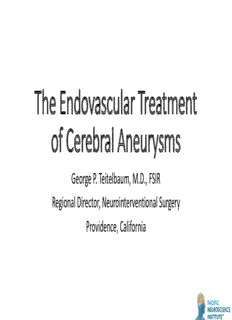
The Endovascular Treatment of Cerebral Aneurysms PDF
Preview The Endovascular Treatment of Cerebral Aneurysms
The Endovascular Treatment of Cerebral Aneurysms George P. Teitelbaum, M.D., FSIR Regional Director, Neurointerventional Surgery Providence, California Types of Stroke and Their Causes • Ischemic (87%): due to blockage of blood flow • Narrowed or occluded artery in the neck or brain • Blood clot migrating to the brain especially from the heart (50% from A-fib) or from a narrowed blood vessel • Hemorrhagic (13%): • Bleeding in the brain especially due to HTN • Rupture of a brain aneurysm • Vascular malformation (AVM or DAVF) Fisher CT grading scale for SAH The Hunt and Hess scale describes the severity of subarachnoid haemorrhage, and is used as a (1980) predictor of survival I – no blood grade 1 II – diffuse deposition of SAH asymptomatic or minimal headache and slight neck stiffness without clots or layers of blood 70% survival >1mm grade 2 moderate to severe headache; neck stiffness; no neurologic deficit except cranial nerve palsy III – localized clots and/or vertical 60% survival layers of blood 1mm or > thickness grade 3 drowsy; minimal neurologic deficit 50% survival IV – diffuse or no subarachnoid grade 4 blood but intracerebral or stuporous; moderate to severe hemiparesis; possibly early decerebrate rigidity and vegetative disturbances intraventricular clots 20% survival grade 5 deep coma; decerebrate rigidity; moribund 10% survival Intracranial Aneurysms • Usually due to congenital weak spot on brain artery that balloon out over time causing “bubble” on brain artery prone to rupture. • Can also be due to infection (“mycotic” aneurysm), polycystic kidney disease, fibromuscular dysplasia, NF, aortic coarctation, trauma, vascular dissection, AVMs, and can uncommonly be familial. • Aneurysm rupture usually presents as “the worst headache of my life,” but can also cause collapse, coma, seizure, and immediate death. Acute bleed usually causes marked HTN and bradycardia. • May also be discovered due to compression of a cranial nerve diplopia, ptosis, etc. • U.S. prevalence: 2-5% of population • Finish unruptured aneurysm study estimated annual risk of aneurysm rupture approx. 1.3%. Risk greater for large (>10 mm) and giant (>25 mm) size and vertebrobasilar aneurysms • Two or more aneurysms can be present in same patient in up to 34% of cases Intracranial Aneurysms • Cause 30-40,000 SAH annually in U.S. • Risk factors: age >60, size >10mm, smoking, previous SAH, HTN, hyperlipidemia, female sex • 1st bleed: 40% die, 50% of survivors disabled, 50% rebleed rate w/ no Rx. 70% mortality w/ 2nd bleed. • Delayed effects of SAH: vasospasm, seizure, hydrocephalus, hyponatremia, Takotsubo (octopus pot) cardiomyopathy • Data reveals that coiling of aneurysms is less risky than surgery w/ recent SAH (ISAT Trial) • At PSJMC, >90% of aneurysms now treated with endovascular methods • Neuroform, LVIS, and Enterprise intracranial stents have made treatment of “wideneck” aneurysms possible • Pipeline embolization device (tightly woven stent) treats wideneck/fusiform large (>10 mm) and giant (>25 mm) aneurysms with flow diversion Annual Risk of Aneurysm Rupture • Wiebers et al reported 5 year risk of anterior circulation lesions <7mm=0% (Lancet 2003;362(9378):90-1) • However, small (<10 mm) aneurysms have accounted for 75% and 70% of aneurysmal ruptures at UCLA and Johns Hopkins U, respectively (Western Stroke Symposium, 2005) • Yonekura reported an annual rupture risk of incidental aneurysms <5mm in diameter = 0.8% (Neurol Med Chir (Tokyo) 2004;44(4):213-4) • Juvela et al reported the annual risk of hemorrhage from a non-ruptured aneurysm is 1.3% (J Neurosurg 2000;93(3):379- 87) Risk Factors for Cerebral Aneurysm Rupture • Hypertension • Age > 60 yrs • Size of aneurysm >10 mm • Rapid recent growth and/or complex shape • Previous SAH • Female sex • Posterior circulation aneurysms • Increased risk during sex and straining to defecate www.thelancet.com/neurology Vol 13 January 2014
Description: